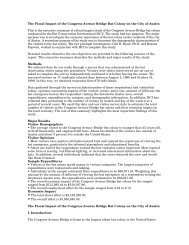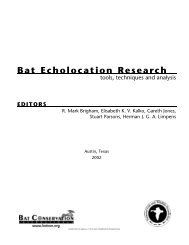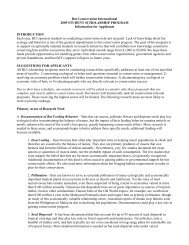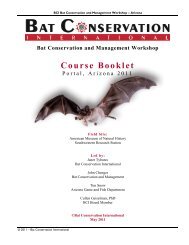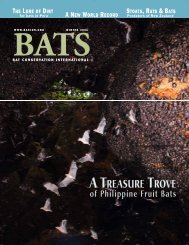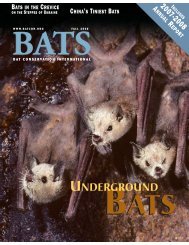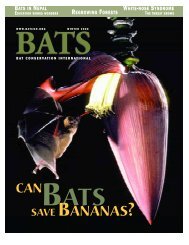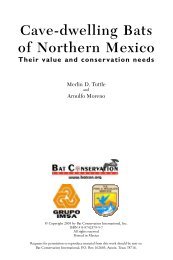Annual Report_09-10 - Bat Conservation International
Annual Report_09-10 - Bat Conservation International
Annual Report_09-10 - Bat Conservation International
You also want an ePaper? Increase the reach of your titles
YUMPU automatically turns print PDFs into web optimized ePapers that Google loves.
T h e P a s t Ye a r<br />
I / 000 1517<br />
Dear BCI Members and Fr iends,<br />
BCI<br />
had a year filled with transitions. Probably the most significant was the resignation of Executive<br />
Director Nina Fascione on April 30, 2012. Nina led <strong>Bat</strong> <strong>Conservation</strong> <strong>International</strong> through two critical years following<br />
the retirement of BCI Founder Merlin Tuttle. The Board of Trustees, with input from BCI staff, has begun the<br />
search for a new Executive Director. The organization, meanwhile, is moving confidently forward under the capable<br />
direction of its dedicated staff and board.<br />
We are approaching BCI’s wide-ranging conservation efforts, both current and planned, with a new commitment<br />
to global bat conservation. This still-developing strategy is centered on conserving the 1,250-plus bat species in the<br />
face of varied threats around the globe, with an emphasis on the bats of North America, Asia-Pacific, Latin America<br />
and Sub-Saharan Africa.<br />
Specific threats and conservation needs vary greatly by geography and species. But sustainable success – whether<br />
reacting to White-nose Syndrome in the United States, protecting cave bats in Mexico, managing habitat loss in<br />
Ghana or controlling hunting of flying foxes in Indonesia – is grounded in a philosophy of working within networks,<br />
partnerships and collaborations with agencies, organizations and committed individuals. Our greatest impacts come<br />
when we help build and nurture local commitments and capabilities that will ensure bat conservation for many years<br />
to come.<br />
The seeds of bat conservation are being sown through BCI’s research and conservation workshops, Student Research<br />
Scholarships and Global Grassroots <strong>Conservation</strong> Fund grants. Our rejuvenated Education Department has,<br />
among many other activities, forged a powerful new alliance with the international Association of Zoos and Aquariums<br />
(AZA), including a special team centered on activities for the 2012 <strong>International</strong> Year of the <strong>Bat</strong>. Over the past<br />
year, hundreds of bat-education events have been held around North American and much of the world, often using<br />
materials produced by BCI.<br />
We are especially excited about recent successes in forging and advancing important international partnerships.<br />
Key among these is the active role BCI is playing in the Southeast Asian <strong>Bat</strong> <strong>Conservation</strong> Research Unit<br />
(SEABCRU), including participation on its steering committee. The organization, with members from throughout<br />
the region, is developing and executing long-term plans for bat conservation. Also noteworthy is the Memorandum<br />
of Understanding for collaboration that BCI signed this year with the Latin American <strong>Bat</strong> <strong>Conservation</strong> Network<br />
(known as RELCOM). The network, with 17 member countries so far, is rapidly becoming the most important force<br />
for conservation of bats in Latin America. BCI is forging important<br />
partnerships in Africa, as well, where BCI-led efforts are<br />
bearing fruit in a multinational summit scheduled for February<br />
2013 to create a bat-conservation network there.<br />
The plague of WNS remains the overriding bat-conservation<br />
issue in North America. The death toll in 19 U.S. states and<br />
four Canadian provinces now exceeds 5.7 million bats. BCI is<br />
working with partners to find a solution to this devastating disease<br />
through education, congressional outreach, conservation<br />
planning and direct research and conservation efforts. This past<br />
year, we provided more than $85,000 in support for vital research<br />
projects aimed at WNS. The turbines of wind energy<br />
also exact a huge toll on bats, perhaps hundreds of thousands a<br />
year. We continue intense efforts to provide effective solutions<br />
to sharply reduce this slaughter.<br />
That’s just a sampling of what <strong>Bat</strong> <strong>Conservation</strong> <strong>International</strong>,<br />
with its tireless staff and enthusiastic partners, is accomplishing<br />
in global conservation. And there is much more to<br />
come in the year ahead.<br />
John Hayes stepped down as Chair of BCI’s Board of Trustees on June 1,<br />
2012. He remains on the Board of Trustees. The Board appointed Dave<br />
Waldien, BCI Vice President of Operations and <strong>International</strong> Programs,<br />
to serve as Interim Executive Director.<br />
Dave Waldien<br />
Interim Executive Director<br />
John Hayes<br />
Chair<br />
Board of Trustees<br />
Cover photo: This rarely seen Allen’s big-eared bat (Idionycteris phyllotis) was captured and released at a BCI <strong>Bat</strong> <strong>Conservation</strong> and Management<br />
Workshop in May 2012.<br />
© Lee Mackenzie, BCI<br />
2 B aT C o n s e rvaT i o n i n T e r n aT i o n a l<br />
©MERL<br />
IN D.<br />
TUTT LE, BC



